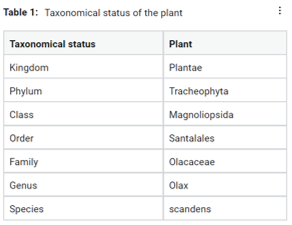Abstract
Plants had been a source of food for human beings from the start of the evolution of mankind. Besides food, herbs served us as the source of medicines to treat ailments. Plants had been investigated for the chemical moieties that are potent in treating many diseases. With the development of science and technology, there had been various drugs, synthesized to treat diseases. But the chemicals that were synthesized had serious adverse effects and side effects. So there has been a focus on herbs and medicinal plants in search of the alternatives for synthetic drugs. In this paper, Olax scandens had been reviewed for its Pharmacognostic, Phytochemical and Pharmacological profiles which revealed the presence of various phytoconstituents like glycosides, tannins, phenols, flavonoids, alkaloids etc. Few areas include the Himalayas and sub- Himalayan regions like northern parts of Bihar, Kumaon. The plant also grows widely in Deccan forest and the Western Ghats. The plant is native to countries like India, Srilanka, Bangladesh, Malaysia, Burma, Thailand, Vietnam and Java. Olax is s scandent shrub which grows to 5m height. The leaf is simple, alternate and oblong with the lanceolate surface. The inflorescence is axillary, racemose and panicle. The flowers are white, and the fruits are drupes and ovoid in shape. The plant was proven to exhibit anti-bacterial, laxative, anti-inflammatory, anti-diabetic, antipyretic activities.
Full text article
References
Acharya, R., Borkar, S., Naik, R., Shukla, V. 2015. Evaluation of phytochemical content, nutritional value and antioxidant activity of Phanji - Rivea hypocrateriformis (Desr.) Choisy leaf. AYU (An International Quarterly Journal of Research in Ayurveda), 36(3):298–298.
Forgacs, P., Provost, J. 1981. Olaxoside, a saponin from Olax andronensis, Olax glabriflora and Olax psittacorum. Phytochemistry, 20(7):1689–1691.
Khare, C. 2007. Olax scandens Roxb. Indian Medicinal Plants, pages 55–91.
Mohapatra, S. B., Swain, D., Mohanty, R. C., Das, P. 2017. Olax scandens Roxb: A Rarefied Non- Edible Potential Leafage of Bio Diesel for Diesel Engines. International Journal of Engineering Technology Science and Research, 4(11):514–525.
Mujeeb, A. A., Khan, N. A., Jamal, F., Alam, K. F. B., Saeed, H., Kazmi, S., Owais, M. 2020. Olax scandens Mediated Biogenic Synthesis of Ag-Cu Nanocomposites: Potential Against Inhibition of Drug-Resistant Microbes. Frontiers in Chemistry, 8.
Mukherjee, S., Chowdhury, D., Kotcherlakota, R., Patra, S., B, V., Bhadra, M. P., Sreedhar, B., Patra, C. R. 2014. Potential Theranostics Application of Bio-Synthesized Silver Nanoparticles (4-in-1 System). Theranostics, 4(3):316–335.
Naik, R., Acharya, R., Nariya, M., Borkar, S. 2015. Evaluation of acute toxicity and intestinal transit time of Olax scandens Roxb. leaves. AYU (An International Quarterly Journal of Research in Ayurveda), 36(4):437–437.
Naik, R., Borkar, S., Harisha, C., Acharya, R. 2013. A Detailed Pharmacognostical Evaluation on Leaf Of Olax scandens Roxb. Global J Res. Med. Plants & Indigen. Med, 2(4):246–253.
Ovais, M., Ayaz, M., Khalil, A. T., Shah, S. A., Jan, M. S., Raza, A., Shahid, M., Shinwari, Z. K. 2018. HPLC- DAD finger printing, antioxidant, cholinesterase, and α-glucosidase inhibitory potentials of a novel plant Olax nana. BMC Complementary and Alternative Medicine, 18(1).
Owk, A., Naidu, L. 2016. Evaluation of Antimicrobial Activity And Phytochemicals In Olax scandens Roxb. Roots. Pharma science monitor, 7:232–239.
Pranaya, P., Devi, D. A. 2020. An Investigation of free radical scavenging activity of various extracts of Olax scandens (family Olacaceae). International Journal of Research in Pharmaceutical Sciences, 11(1):397– 402.
Prabhakar, G., Kamalakar 2014. Phytochemical investigation of whole fruit of Olax scandens Roxb. Journal of Applied Science and Research, 2(3):53– 60.
Raghavendra, N., Sneha, B., Acharya, D., N, R. 2015. Evaluation of Antipyretic Activity of Olax Scandens (Roxb.) Stem Bark. Pharmacology, 5(1):15–18.
Rajalakshmi, K., Shanmugapriya, P., Christian, G. J., Gladys, J., Banumathi, V., Geethalakshmi, S. 2018. Antimicrobial Potential of Siddha Polyherbal Formulation Aavarai Kudineer. Journal of Pure and Applied Microbiology, 12(2):1019–1025.
Scandens, R. O. 2019. Olax scandens Roxb. in GBIF Secretariat. GBIF Backbone Taxonomy. Accessed 2020-09-05.
Sreeramulu, N., Suthari, S., Ragan, A., Raju, V. S. 2013. Ethno-botanico-medicine for common human ailments in Nalgonda and Warangal districts of Telangana. Annals of Plant Sciences, 2(07):220–229.
Swamynathan, B., Ramamoorthy, D. 2011. Flora of sacred groves (Tropical dry evergreen forest) and its ethno botanical importance on the coromandel coast of peninsular India. Journal of research in Biology, 2:88–92.
Authors

This work is licensed under a Creative Commons Attribution-NonCommercial-NoDerivatives 4.0 International License.

